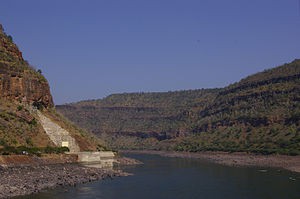Today (November, 12th, 2015), there was an SZ article about a mega project in the “knowledge” category. It was titled: “India links its rivers” and written by Robert Gast. Let me cite:
India links its rivers
In order to distribute the water reserves of the country more evenly, they plan to build 30 channels and 3,000 water reservoirs. It would necessitate moving half a million people.
As early as December, the Indian Government wants to promote the realization of a gigantic infra structure project. Over the next years, they plan to build 3,000 water reservoirs and 30 channels with a total length of 15,000 kilometres. For instance, they want to connect 37 rivers on the sub-continent. The project, which is assumed to cost more than 150 billion Euros, is a reaction to the fact that there is extremely much rain in some regions of India while other regions have extreme aridity. The west and north of the country regularly fight against floods, while the districts in the east and south of the sub-continent again and again suffer under the drought.
 Consequently, India started as early as ten years ago making plans to connect the great rivers of the country. Also, they want to pond rivers, especially in the Himalaya region. This is how engineers want to store excess water and then transfer it to dry parts of the country. They plan to re-route 174 billion litres of water each year. Farmers could then work their fields in times of drought, as well, says the Indian Authority for Water Development – who promote the channel building project. On top of this, they also plan to install water-driven power stations with a total capacity of 34 gigawatts.
Consequently, India started as early as ten years ago making plans to connect the great rivers of the country. Also, they want to pond rivers, especially in the Himalaya region. This is how engineers want to store excess water and then transfer it to dry parts of the country. They plan to re-route 174 billion litres of water each year. Farmers could then work their fields in times of drought, as well, says the Indian Authority for Water Development – who promote the channel building project. On top of this, they also plan to install water-driven power stations with a total capacity of 34 gigawatts.
However, the project meets resistance among the citizens. According to a study done by Upali Amarasinghe of the International Water Management Institute of 2008, more than half a million persons would probably have to be relocated. Environmentalists think the project intervenes too strongly with nature. For instance in the tiger reservation of Panna. After all, they plan to pool the river Ken and re-route it to merge with the Betwa river through a 230 kilometre channel as part of the channel project. Yet this would cause the flooding of parts of the national park and 1,600 families would have to move. Additionally, the 32 tigers living in the reservation would become totally isolated from other preserved areas. Regardless, the Indian government is determined to run the project. In September, they already inaugurated a new waterway between the rivers Krishna and Godavari in the south-west of India.
For me, this article was interesting for several reasons. Firstly, this project might well be the world’s biggest project. Secondly, there are many similar projects all over the world. They all want to facilitate access to water, initiating huge geographical changes. Because water gets more and more dear. And perhaps India does not really have a choice if they want to cope with the expected climate changes like long droughts and extreme amounts of rain.
Except that, to me, this all does not really sound sustainable in terms of our planet. Perhaps India and all these many other countries planning similar projects can postpone their collapse by a few decades. But in the end, it reminds me a little of the “thinking in terms of the next three months” as practiced by the concerns. Except that, in politics, the three months are a little longer and perhaps closer to a five-year period.
Perhaps we should, along with these projects that might well be necessary, try to heal the worst destructions we subjected our planet to during the last hundred years?
RMD
(Translated by EG)
P.S.
About the author:
Robert Gast, born in 1984, is editor in the science sector of the Süddeutsche Zeitung. He studied physics and wrote his diploma thesis about Gamma Radiation in Space. Afterwards, he worked on a nine-months grant of the „Initiative Scientific Journalism “. This initiative gave scientists a journalistic training. Before signing up with SZ, he had worked for some time editing the “Zeit”, as well as the “Frankfurter Allgemeinen Sonntagszeitung”, the “Stuttgarter Zeitung”, the “Deutschen Presse-Agentur dpa” and the “Spektrum der Wissenschaft”. In 2013, he was awarded the Georg von Holtzbrinck Preis für Wissenschaftsjournalismus (category: young academics).
About the photo:
Krishna River Gorge by Srisailam, Andhra Pradesh, India, 13 January 2008, own work of Zeman, the file is licensed under the Creative Commons Attribution-Share Alike 3.0 Unported license.

